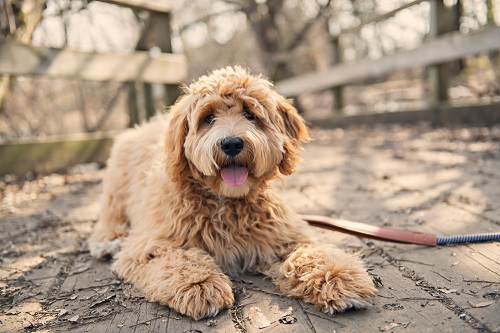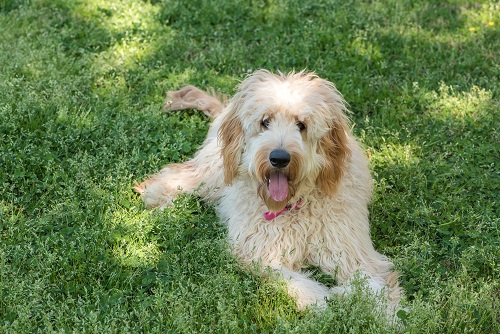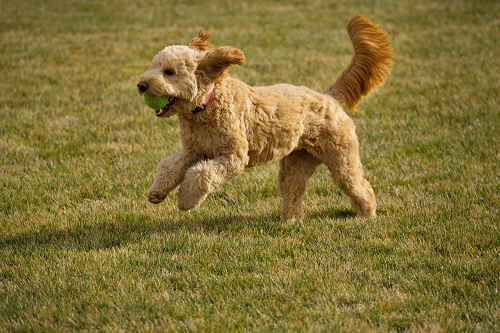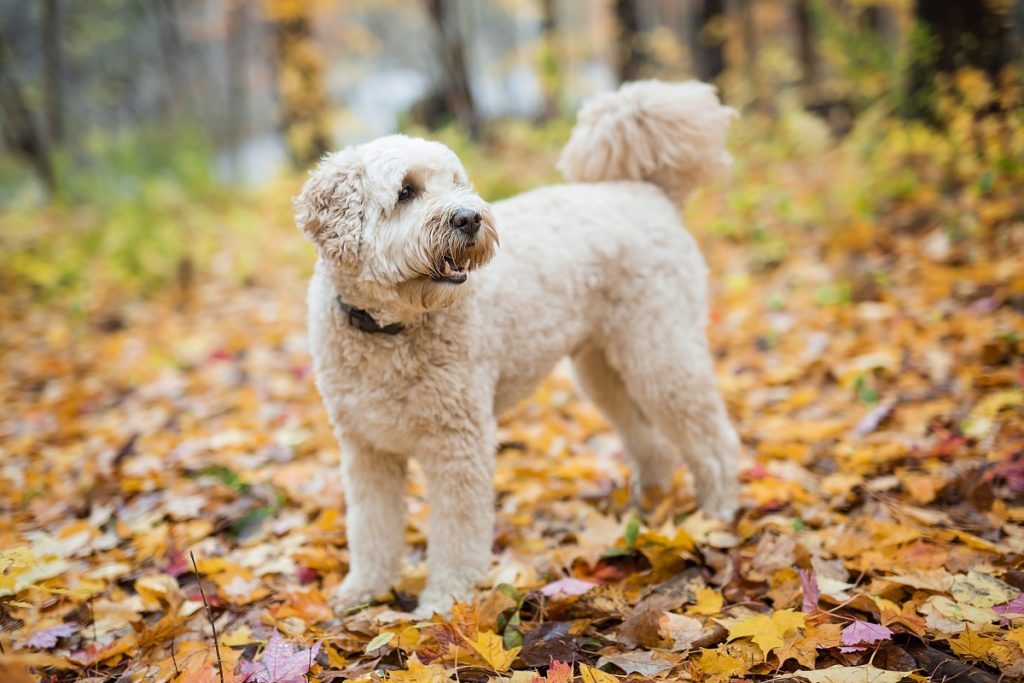From lifelong dog lovers to first-time pet parents, it’s helpful to know the background of a dog’s breed, specifically when it comes to his overall health, nutritional needs and proper care regimen. However, it’s also important to understand how he or she may fit into a household from a personality perspective. For prospective fur-baby folks who may be considering a new four-legged addition to the family, a Goldendoodle may be the perfect fuzzy friend – great with children and typically easy-going pups, these social creatures make them wonderful family pets. Read on for more useful information about this breed, including the Goldendoodle personality, temperament, its history, personality traits, and more.
Goldendoodle Temperament & History
- History: A “designer” breed developed in the 1990s, the Goldendoodle – also known as the ‘Groodle’ – is known to be an affectionate and gentle-mannered dog. Since they’ve only been bred within the last few decades, many of today’s litters are the result of first-generation breeding between Golden Retrievers and Poodles. When it comes to the temperament of the Golden Doodle, owners happily report that these pups are well-mannered, social, and have a loving disposition. As a result of their mild-mannered personality and friendly temperament, these loveable cross-bred pooches have increased in popularity in recent years.
- Size: When it comes to size, Goldendoodle pooches can vary in dimension and weight from small to quite large, depending on the type of Golden Retriever and Poodle his parents were. Initially bred as a bigger version of the well-loved Cockapoo, this breed has become a great family dog amongst canine enthusiasts.
- Social Tendencies/Personality Traits: This breed is known for their social temperament, gentle disposition and ability to get along with children as well as adults. However, their overtly friendly nature is the very reason why they don’t make good guard dogs or watch dogs; therefore, they shouldn’t be used for such purposes. Goldendoodles do well in both urban and rural environments, although they don’t fare well in apartment situations, since they tend to thrive in living spaces where they have regular access to the outdoors. On the other hand, this breed should not live in a kennel or outside, as they require frequent contact and affection from their owners.
- Skills/Attributes: One of the more notable assets of the Goldendoodle is their versatility as working dogs. With a proven success rate as therapy dogs, guide dogs, service dogs, and even sniffer dogs (e.g., they have the ability to sniff out foods their owners may be allergic to), these hard-working canines are not only excellent domestic companions, but valuable service animals as well. Additionally, the breed is known for its agility and responsiveness, which goes hand in hand with the desirable qualities required of service dogs.
Goldendoodle Training and Care: Useful Tips & Suggestions
Training Your Goldendoodle
According to the American Kennel Club, both Poodles and Golden Retrievers made their list of “most trainable breeds” – so it should come as no surprise that the Goldendoodle carries the strengths and excellent characteristics of each breed. Naturally intelligent, these mix breed dogs are frequently recommended for first-time dog owners, as they’re not only easy to train, but eager to please their pet parents. They’re also a good fit for shy or reserved folks, since they’re not aggressive in nature.
However, it’s important to socialize young Goldendoodles early on in order to reduce the incidence of fearful, timid or guarded behavior around other pets or humans. In addition, most experts agree that it is best to train this breed using plenty of positive reinforcement, as harsh scolding may damage his confidence.
Furthermore, Goldendoodles require daily (and frequent) socialization with their owners, since they’re prone to bouts of canine separation anxiety if they are left alone for extended periods of time. Some experts recommend crating Goldendoodles who are prone to destructive behavior when left alone – providing tasty treats, toys, and a favorite blanket will help an anxious dog relax and stay busy while his pet parents are at work or running errands. For dog owners who may be gone for more than a few hours at a time, keeping the TV or radio on may also prove beneficial for fretful pups.
Caring For Your Goldendoodle
When it comes to caring for a Goldendoodle pooch, these dogs have a fairly average energy level, so they’ll need to exercise daily as part of their routine. Typically, 20 minutes to a half an hour of running around the yard, going for a brisk walk in the park or on a leash through the neighborhood should provide adequate physical activity while preventing boredom. Since he’s part Retriever, it’s natural that Goldendoodles love water – so for dog owners lucky enough to have a pool, frequent beach-goers, or folks who enjoy spending time at lakes or streams, these dogs will enjoy themselves as much as (if not more than) their family will!
Depending on his parents’ size and stature, a Goldendoodle may grow up to be a large-sized adult dog, so he requires plenty of space to move around. Therefore, most dog experts advise owners against getting this type of dog if they live in an apartment, since they won’t have adequate room to move around freely. Goldendoodles do best in homes where they have access to a fenced-in yard or other outdoor space to run and play. However, they’re not necessarily “outdoor” dogs and shouldn’t be kept in a kennel or in a dog house – since they’re very social creatures, they thrive living inside the house with their pet parents.
Feeding Your Goldendoodle
Because no two dogs are exactly the same, there is no set amount when it comes to feeding one’s pet. Although it takes a certain degree of common sense, when determining the recommended daily amount of dry or wet food to feed an adult Goldendoodle, it really depends on his size, build, age, metabolism and activity level – for example, a very active dog will require more nourishment than a sedentary pooch. It should also be noted that puppies and younger dogs require a different feeding schedule. Ultimately, a trusted vet should be consulted regarding his nutrition, as he or she can help to determine not only how often to feed the family dog, but what type of pet food is best for his dietary needs. The vet may also suggest specially-formulated dog supplements to help balance out his diet and ensure he’s getting all of the essential vitamins and minerals required, as well as recommend other natural canine supplements treats that may reduce his anxiety or other minor health issues he may be experiencing.
 In order to keep a dog in good physical condition, many pet experts suggest measuring his food and feeding him just two times a day, instead of leaving his food dish out around the clock. Furthermore, feeding a Goldendoodle several smaller meals each day versus one large meal is actually safer – being he’s half Golden Retriever, he is prone to gastric torsion (also known as gastric dilatation-volvulus or canine bloat), a trait that is commonly found in Retrievers. This life-threatening condition affects Goldendoodles; without immediate medical attention, bloat can even be fatal (this condition will be discussed in greater detail below under “Health Conditions”). Therefore, it’s important to speak with a vet regarding appropriate feeding times, type(s) of food, and other helpful guidelines to ensure his weight, exercise, nutritional needs and overall health requirements are being met.
In order to keep a dog in good physical condition, many pet experts suggest measuring his food and feeding him just two times a day, instead of leaving his food dish out around the clock. Furthermore, feeding a Goldendoodle several smaller meals each day versus one large meal is actually safer – being he’s half Golden Retriever, he is prone to gastric torsion (also known as gastric dilatation-volvulus or canine bloat), a trait that is commonly found in Retrievers. This life-threatening condition affects Goldendoodles; without immediate medical attention, bloat can even be fatal (this condition will be discussed in greater detail below under “Health Conditions”). Therefore, it’s important to speak with a vet regarding appropriate feeding times, type(s) of food, and other helpful guidelines to ensure his weight, exercise, nutritional needs and overall health requirements are being met.
Goldendoodle Health Conditions: What Every Pet Parent Should Know
While Goldendoodles are typically healthy dogs, they are still susceptible to some health conditions as all breeds are. Although not every Goldendoodle will get any (or all) of these conditions or diseases, it’s still essential for pet parents to be aware of them. Whether adopting a Goldendoodle for the first time or simply educating oneself for proper care purposes, being proactive about his healthcare is crucial for his longevity and overall health. It’s therefore important for owners of this breed to know about the following diseases and conditions in order to be aware of the signs and symptoms, as well as contact or visit a vet immediately should the need arise:
- Allergies: Unfortunately allergies are a common problem among dogs, and the Goldendoodle breed is no exception. The three main types of canine allergies include inhalant allergies (triggered by allergens such as pollen, mildew and dust), dog food allergies (treated by eliminating suspect foods from a dog’s diet), and contact allergies (caused by a reaction to topical substances, such as dog shampoos, flea powders, and other chemical products). Depending on the type of allergies a dog may suffer, his veterinarian may include treatments that involve environmental changes, restrictions in his diet, or medications.
- Elbow Dysplasia: A degenerative disease, this condition is believed to be the result of abnormal growth and development, thus resulting in a weakened and malformed joint. However, canine elbow dysplasia varies in severity – some dogs will only develop inflammatory arthritis, while others may eventually become lame. There are several approaches to treatment that your vet may recommend, including anti-inflammatory medication, weight management, and even surgery, depending on how acute the diagnosis is.
- Ear Infections: Due to the floppy nature of their ears, Goldendoodles are prone to canine ear infections. Because moisture gets easily trapped inside, it’s important to check ears regularly to make sure there are no signs of infection. For pet parents who are hesitant to clean their Goldendoodle’s ears, a skilled groomer can do so during grooming appointments.
- Gastric Dilatation-Volvulus: Also known as gastric torsion or bloat, Gastric Dilatation-Volvulus (GDV) in dogs is a life-threatening condition that typically affects big, deep-chested dogs including large-breed Goldendoodles. GDV arises specifically if a dog:
- Is fed one large meal a day
- Eats very rapidly (i.e., “wolfs” down his meal)
- Drinks a large quantity of water post-meal
- Engages in vigorous exercise after mealtime
This condition is seen more frequently among older dogs and occurs when the dog’s stomach is distended with air or gas, and then twists (also known as ‘torsion’). As a result, the dog is unable to belch or vomit to get rid of the excess air in his stomach, and the normal return of blood to the heart is inhibited. Consequently, the dog’s blood pressure will drop and he will go into shock. It is therefore of utmost importance to seek immediate medical care, as the dog is at risk of dying if not treated right away. For the safety of their pets, owners of large-breed Goldendoodles should be aware of the signs of bloat, which include:
- Distended abdomen
- Excessive salivation
- Retching or burping without throwing up
- Signs of weakness with a rapid heartbeat
- Restlessness
- Depression or lethargy
If one or more of these signs are apparent, it is imperative to get the dog to the vet as quickly as possible.
- Hip Dysplasia: While sometimes the result of malnutrition in dogs, canine hip dysplasia is typically an inherited condition in which the affected dog’s thigh bone does not fit snugly into his hip joint. In certain cases, a dog may display signs of discomfort and lameness on either one or both rear legs, whereas other dogs don’t show any outward signs of pain. In either case, arthritis may develop as a dog matures. If canine hip dysplasia is suspected, the most definitive way to diagnose the condition is through an X-ray screening at a trusted veterinarian’s clinic. In the event that the owners plan on breeding, experts advise against breeding dogs who have been diagnosed with this condition. Therefore, for prospective pet owners who are planning to buy a puppy, it’s important to ask the breeder for documentation that the dog’s parents were tested for hip dysplasia and show no signs of the condition.

- Hypothyroidism: A disorder of the thyroid gland, hypothyroidism is a condition that is seen in canines as well as humans. It has been linked to a variety of canine health problems, including obesity, lethargy, hyperpigmentation, epilepsy, alopecia (hair loss), pyoderma, and other skin conditions. A trusted vet can prescribe the best treatment for this condition, which may involve dietary changes and in some cases, medication.
- Progressive Retinal Atrophy (PRA): This is a grouping of canine eye diseases that entail the gradual deterioration of the retina. Early on in canine progressive retinal atrophy, affected dogs typically become night-blind; eventually, they will lose their day vision as well as the disease progresses. In most cases, dogs are capable of adapting to their limited/lost vision, as long as their surrounding environment remains relatively the same.
- Von Willebrand’s Disease (vWd1): A blood disorder that affects the clotting process, this disease is found in dogs as well as humans. Dogs suffering from the disease may have symptoms including:
- Bleeding gums
- Blood in stool on occasion
- Nosebleeds
- Prolonged bleeding during heat cycles/after whelping
- Prolonged bleeding from surgery
Canine Von Willebrand’s Disease is usually diagnosed in dogs between the ages of three and five, and unfortunately, there is no cure. However, the disorder can be managed with treatments, precautionary medical procedures, and avoiding certain medications.
- Patellar Luxation: Another commonly-seen problem in small dogs, patellar luxation is also known as slipped stifles. By definition, the patella is the kneecap, whereas ‘luxation’ refers to the dislocation of some part of the anatomy (e.g., a bone at a joint). In the case of patellar luxation, the dog’s knee joint (usually seen at the site of the hind legs) slips in and out of place, causing discomfort. Although it can be painful and sometimes crippling, most dogs who have this condition lead fairly normal lives.
Helpful Tip:
For pet parents interested in adopting or purchasing a Goldendoodle puppy, be sure to research the breeder in advance. A reputable breeder should be able to provide health clearances for both of the puppy’s parents. Health clearances prove that a dog has been tested and cleared of a specific condition, and can help prospective pet owners determine the health of their future furry family member.
Sources Cited:
- “Goldendoodles 101: History and Personality.” Everything Doodle.com, (no publish date), http://www.everythingdoodle.com/goldendoodle-101-history-personality/. Accessed September 17, 2019.
- “Goldendoodle.” Dogtime.com, (no publish date), https://dogtime.com/dog-breeds/goldendoodle. Accessed September 17, 2019.
- “Goldendoodle.” PetGuide.com, (no publish date), https://www.petguide.com/breeds/dog/goldendoodle/. Accessed September 17, 2019.
- Gibeault, Stephanie, MSc, CPDT. “13 of the Most Trainable Breeds.” AKC.org, January 18, 2018, https://www.akc.org/expert-advice/lifestyle/13-of-the-most-trainable-breeds/. Accessed September 17, 2019.




